-
Posts
14,343 -
Joined
-
Last visited
-
Days Won
25
Content Type
Profiles
Forums
Blogs
Gallery
Events
Store
Posts posted by Ed_Haynes
-
-
More on the Order of the Somali Star:
Established: Unknown. Known to have been manufactured by Pozzi (Rome, Italy).
Obverse: Five-pointed white and blue enameled star (each point half white and half blue), leopard in the center, walking to the left. Suspended by a crescent and star OR crescent and enameled wreath enclosing a large ?S?? Two varieties here, but what dates?
Reverse: Inscription ?RS?.
Ribbon: Equal stripes: blue, white, blue.
-- grand cross ? sash, sash badge, and breast star
-- commander -= neck badge
-- officer - breast badge, rosette (?)
-- knight - breast badge
0 -
Wisam Batal al-Jamhuriya / Hero of the Republic
Awarded to members of the Syrian Armed Forces for extraordinary combat performance which results in a decisive shift of battle in favor of Syria and to air force pilots for five air victories. The medal may also be awarded to civilians and to other Arabs engaged in battle side-by-side with Syrian forces. It may be awarded more than one time (in which cases the ribbon, when worn alone, bears a bronze Syrian eagle) and may be awarded posthumously.
Established: By Legislative Decree No. 75 of 20 October 1973.
Obverse: An eight-ended jeweled star with square points with smaller points between these. In the center an ancient Arab waraior on horseback. Worn around the neck from a depiction (enameled?) of the Syrian arms.
Reverse: Presumably plain.
Ribbon: Pale blue (also said to be black?), with six white stripes. Worn as a neck badge.
All I have is a drawing, sorry.

 1
1 -
Wisam Umayad al-Watani / National Order of the Ummayad
Syria?s highest order is named in honor of the Ummayad Dynasty (88-167 A.H., 671-750 C.E.). It is very rarely awarded for outstanding civilian and military services. It is also awarded to selected foreign dignitaries.
Established: 12 July 1934. Known to have been manufactured by Bichay (Cairo, Egypt).
Obverse: A multi-rayed, eight-pointed silver star. In the silver-gilt center, surrounded by a gold fretwork, a white-enameled medallion, surrounded by a green-enameled band, with the Arabic inscription in gold: ?Ummayad?. Suspended by a ring.
Reverse: Presumably plain.
Ribbon: Green with edge stripes (reading inward) of black, green, and white. Also described as red moir??
-- first class ? sash, sash badge, and breast star
-- second class / commander ? neck badge and breast star
-- third class / commander ? neck badge

 0
0 -
Evacuation Medal
Awarded to officers, military cadets, and other ranks who were serving in the People?s Armed Forces at the time of the evacuation of foreign troops from the Sudan.
Established: By the Decorations and Medals (Amendment) Act No. 30 of 1974 (retroactive to 25 May 1969).
Obverse: Circular 36-mm silvered bronze. A camel rider under the rays of the sun and between two flagstaffs on which the codominium (British and Egyptian) flags have been lowered. It is suspended from a bulbous suspension and straight bar.
Reverse: Arabic legend.
Ribbon: 34 mm, 8 mm red, 6 mm white, 2 mm black, 2 mm white, 2 mm black, 6 mm white, 8 mm red.

 0
0 -
Order of the Two Niles
Awarded for services to the state lesser than those rewarded by the Order of the Republic. The order is awarded both to Sudanese citizens and foreign nationals. The name represents the Blue Nile and the White Nile rivers which join at the city of Khartoum.
Established: 16 November 1961 by President Abboud. Known to have been manufactured by Bichay (Cairo, Egypt) and by Garards (London, England).
Obverse: Two five-ended multi-rayed silver (also seen in silvered copper) stars, each imposed, offset, on the other, producing a ten-ended rayed star of blunt points. In the center, a while medallion with the inscription in dark blue: ?El Nilein?, or ?The Two Niles?. Suspended by a gold medallion with the state emblem.
Ribbon: Royal blue moir? with a silvery white stripe toward each edge.
-- first variety (1961-70) ? Suspended by a silver rhino badge.
---- first class ? A sash (100 mm), sash badge (60 mm), and star (100 mm, worn on left breast). Awarded, approximately, to those of the rank of head of state.
---- second class ? A 54 mm badge suspended from a 36-mm neck ribbon with a 90-mm breast star (worn on the left breast). Awarded, approximately, to those of the rank of cabinet minister or general.
---- third class ? A 54-mm badge suspended from a 36-mm neck ribbon. Awarded, approximately, to those of the rank of colonel or lieutenant colonel.
---- fourth class ? A 50-mm breast badge worn from a 36-mm ribbon (with rosette?). Awarded, approximately, to those of the rank of major and captain.
---- fifth class ? A 50-mm breast badge worn from a 36-mm ribbon. Awarded, approximately, to those of the rank of lieutenant.
-- second variety (1970?) ? Suspended by a silver secretary bird badge.
---- first class ? A sash (100 mm), sash badge (60 mm), and star (100 mm, worn on left breast). Awarded, approximately, to those of the rank of head of state.
---- second class ? A 54 mm badge suspended from a 36-mm neck ribbon with a 90-mm breast star (worn on the left breast). Awarded, approximately, to those of the rank of cabinet minister or general.
---- third class ? A 54-mm badge suspended from a 36-mm neck ribbon. Awarded, approximately, to those of the rank of colonel or lieutenant colonel.
---- fourth class ? A 50-mm breast badge worn from a 36-mm ribbon (with rosette?). Awarded, approximately, to those of the rank of major and captain.
---- fifth class ? A 50-mm breast badge worn from a 36-mm ribbon. Awarded, approximately, to those of the rank of lieutenant.
The second/third class neck badge shown has no suspender?
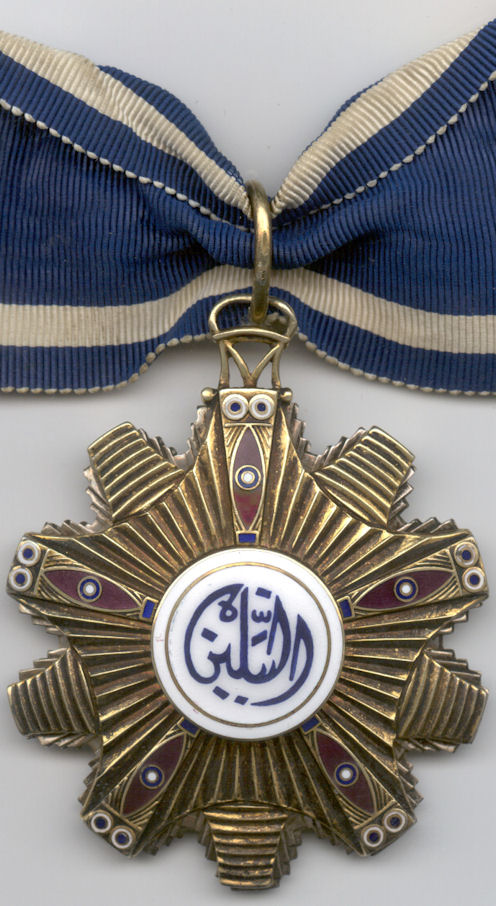
 0
0 -
Order of the Republic
Awarded for general civilian or military service to the state to both Sudanese nationals and foreigners. The general social status of the recipient determines the class awarded.
Established: 14 (16?) November 1961 by President Abboud.
Obverse: A twelve-pointed star (in both gold and platinum according to class? or silver-gilt??), with a central medallion in white enamel and the dark blue inscription in Arabic: ?The Republic of the Sudan?. This is surrounded by a gilt crescent and a band enameled in the colors of the national flag; from this band, a series of points enameled in the colors of the national flag extend into the larger star. The badge is suspended by a medallion with the state emblem, either a silver rhino or a secretary bird.
Ribbon: ???: Green, edged with purple and narrow purple stripes in the center and inside the wider edge stripes. OR: Lilac, with narrow yellow edges, a narrow yellow center stripes, and two narrow yellow stripes toward each side. ??? Reddish-purple with thin gold-yellow stripes.
-- first variety (1961-70) ? The enamel colors in the badge are ???, representing the flag of the day. Suspended by a silver rhino badge.
---- first class ? A sash (100 mm), sash badge (60 mm), and star (100 mm, worn on left breast). Awarded, approximately, to those of the rank of head of state.
---- second class ? A 54 mm badge suspended from a 36-mm neck ribbon with a 90-mm breast star (worn on the left breast). Awarded, approximately, to those of the rank of cabinet minister or general.
---- third class ? A 54-mm badge suspended from a 36-mm neck ribbon. Awarded, approximately, to those of the rank of colonel or lieutenant colonel. (SHOWN BELOW.)
---- fourth class ? A 50-mm breast badge worn from a 36-mm ribbon (with rosette?). Awarded, approximately, to those of the rank of major and captain.
---- fifth class ? A 50-mm breast badge (actually, most badges are slightly smaller as the badge lacks the enameled points at the ends of each star point) worn from a 36-mm ribbon. Awarded, approximately, to those of the rank of lieutenant.
---- medal of merit in gold
---- medal of merit in ???
-- second variety (1970?) ? The enamel colors in the badge are green, white, red, and black, representing the flag of the day. Suspended by a silver secretary bird badge.
---- first class ? A sash (100 mm), sash badge (60 mm), and star (100 mm, worn on left breast). Awarded, approximately, to those of the rank of head of state.
---- second class ? A 54 mm badge suspended from a 36-mm neck ribbon with a 90-mm breast star (worn on the left breast). Awarded, approximately, to those of the rank of cabinet minister or general. (NECK BADGE SHOWN BELOW.)
---- third class ? A 54-mm badge suspended from a 36-mm neck ribbon. Awarded, approximately, to those of the rank of colonel or lieutenant colonel.
---- fourth class ? A 50-mm breast badge worn from a 36-mm ribbon (with rosette?). Awarded, approximately, to those of the rank of major and captain.
---- fifth class ? A 50-mm breast badge (actually, most badges are slightly smaller as the badge lacks the enameled points at the ends of each star point) worn from a 36-mm ribbon. Awarded, approximately, to those of the rank of lieutenant.
---- medal of merit in gold
---- medal of merit in ???
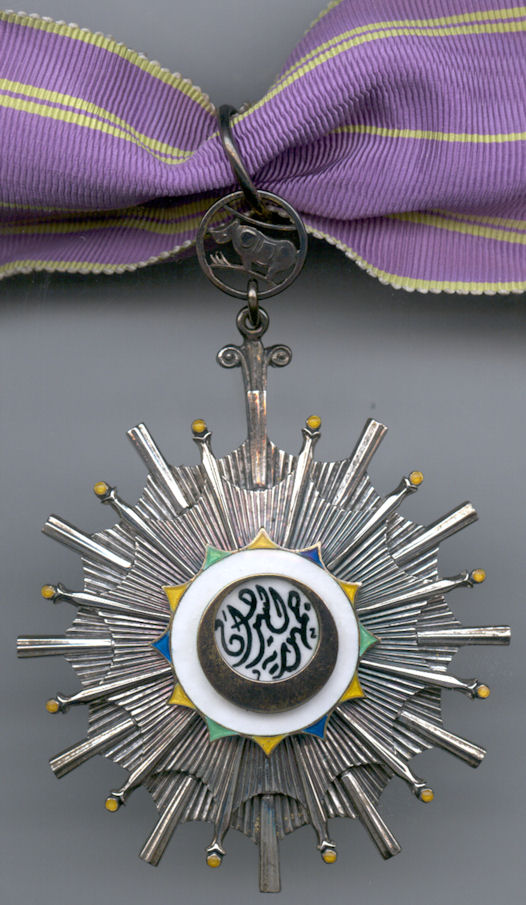
 0
0 -
The Cordon of Honor:
Established: Said to have been founded 1 January 1956 and suspended in 1958. Reinstituted (founded?) by the president (Field Marshal Ibrahim Abboud) in 1961.
Obverse: Differs by division and type, see below.
Obverse: Differs by division and type, see below.
Ribbon: Differs by division and type, see below.
-- Sash of Honor ? Awarded to foreign heads of state (government?) and to a maximum of fifteen Sudanese nationals. The badge is a bronze-gilt star with eight almond-shaped points, each enameled green and bearinga red-enameled oval. The circular central medallion is enameled white and inscribed in Arabic ?Al-Sharaf?; this is surrounded by a gold crescent and an enameled band in the colors of the national flag (see below). The badge is worn on a sash over the shoulder. The breast star is similar in design to the badge. The sash is pinkish-red, with broad white edges and two blue stripes on each of these white edge stripes.
---- first design (1961-70) ? The band surrounding the central medallion is in blue, yellow, and green (representating the flag of the day).
---- second design (1970?) ? The band surrounding the central medallion is in black, white, green, and red (representating the flag of the day).
No images, sorry. Help?
0 -
Cordon of Honor
Worn ex officio by the president, awarded to foreign heads of state, and awarded to selected Sudanese citizens for special merit. While in many ways the Insignia of Honor and the Cordon of Honor are separate awards, they as so linked as to deserve conjoined treatment.
The Insignia of Honor:
-- Insignia of Honor ? Worn ex officio by the president and awarded to foreign heads of state. The badge is four conjoined crescents in gold, superimposed on gold filagree and embelished with stones; it is worn suspended from a collar (described below) or on a sash. The breast star is of the design of the badge but with a central gold and white-enameled lotus flower with a geometric pattern in the color of the Sudanese flag (see below). The sash is cornflower blue, with two pearl-gray stripes toward each edge, the outer stripe half the width of the inner stripe.
---- first design (1961-70) ? The badge when worn on the chain is suspended by a rhinoceros emblem. The enamel on the breast star is in blue, yellow, and green (representating the flag of the day).
---- second design (1970?) ? The badge when worn on the chain is suspended by a secretary bird emblem. The enamel on the breast star is in black, white, green, and red (representating the flag of the day).
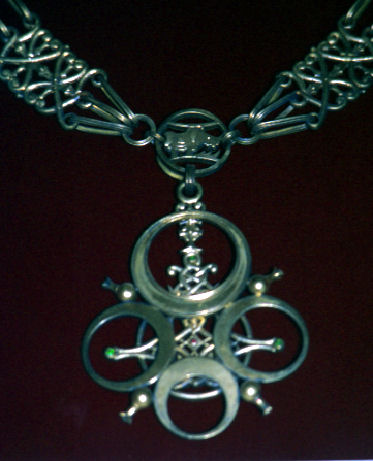
 0
0 -
Wisam al-Amalila al-Herbi Alm 1948 / Medal for War Service, 1948
Also seen referenced as ????? ?Sharat al-Amaliyal al-Harbiah fi Filastin? or ?Medal for War Operations in Palestine?.
As the last survivor of the Arab war of independence, King Adbullah ibn Hussein was appointed as the nominal commander-in-chief of the Arab army which attacked Israel on 15 May 1948. Despite effective combat service by the Arab Army (a.k.a. ?Arab Legion?), Arab successes were minimal (mainly the West Bank in Jordanian hands and the Egyptian possession of the Gaza Strip). An armistice agreement was concluded on 3 April 1949. This medal was awarded for at least seven days of front-line service in Palestine 19 July-15 August (15 March-19 July???) 1948.
Established: By King Abdullah ibn Hussein in 1948.
Obverse: 40-mm octagonal 22-carat gold medal, within an octagonal frame crossed swords surmounted by a crown (the badge of the ?Arab Legion?), above this an Arabic inscription ?Abdullah ibn Hussein? and below dates?1948-1367? ?1367-1948?. Suspended from a crown and straight-bar suspender.
Reverse: Within an octagonal frame, a map of pre-1948 Jordan/Palestine with the legend ?Hashemite Kingdom of Jordan?.
Ribbon: 38 mm red, with broad central white stripe, on that stripe, two narrow stripes, black and green: 9 mm red, 5 mm white, 2.5 mm black, 5 mm white, 2.5 mm green, 5 mm white, 9 mm red.

 0
0 -
Maidalet al-Sharif / The Medal of Honour
Awarded to all members of the military services recognize special service and acts of gallantry.
Established: By King Hussein ibn Talal, July 1972.
Obverse: 38-mm circular gold medal, a trophy of arms with two prominent crossed sabers, surrounded by a wreath and surmounted by an Aran helment. The central device is surrounded by a ring of circles and, on a shield below, the legend ??jr?A? ?Al-Sharia? or ?Honour?. Suspended by an ornamented straight-bar suspender.
Reverse: The Arabic legend ?The Hashemite Kingdom of Jordan? around the top and, in the center, ?Azima Tadhiya wa Fida? or ?Determination and Self-Sacrifice?. Below, the date (establishment or award?) in both Muslim and Christian calendars.
Ribbon: 38 mm, crimson, with golden-yellow edge stripes. The yellow edge stripes have thin edge stripes of green (outer) and black (inner): 2 mm green, 6 mm yellow, 2 mm black, 18 mm crimson, 2 mm black, 6 mm yellow, 2 mm green.
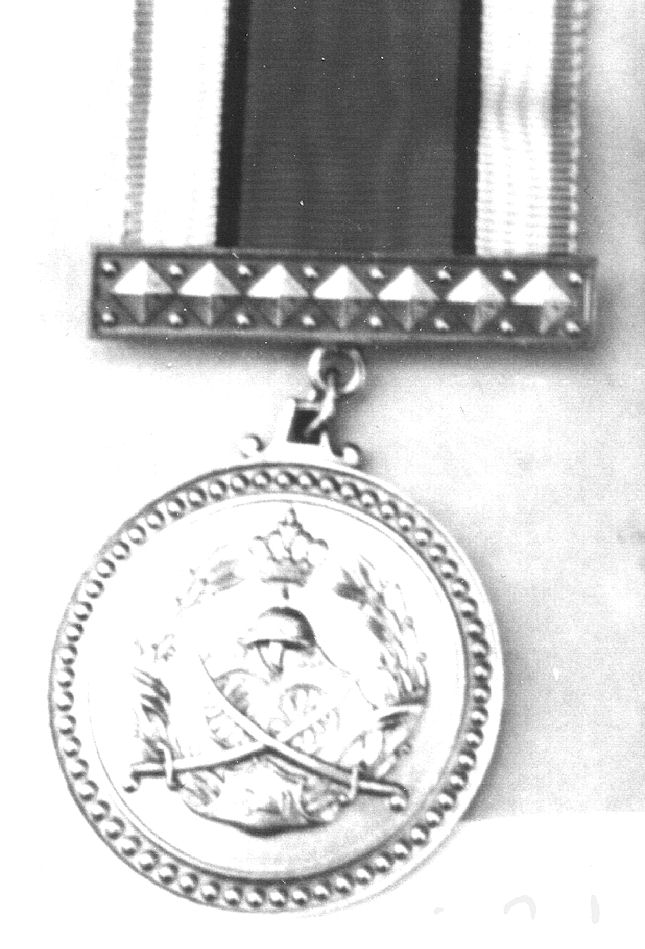
 0
0 -
Wisam al-Istahaqaq al-Askari / The Order of Military Merit
Awarded to all military and civilian personnel for exceptional services to the state, especially as they relate to defense.
Established: By King Hussein ibn Talal in 1976.
Obverse: A seven-pointed white-enameled silver star with ball tips with a gold laurel wreath behind. In the center, seven-pointed faceted silver star with a red-enameled circle bearing the crest of the Jordanian military in gold surrounded by a green-enameled wreath. Suspended by a ring.
Ribbon: Green moir? with black edges and, inside the black, a narrow white / red / narrow white set of stripes. (The colors of the Arab Army.)
Awarded in five classes:
-- first class ? a 52-mm sash badge, 80-mm sash (worn on over the right shoulder), and 98-mm breast star (worn on the left breast) - awarded to generals
-- second class ? a 52-mm neck badge (worn on a 38-mm ribbon) and 98-mm breast star (worn on left breast) awarded to brigadiers and colonels
-- third class ? a 60-mm neck badge worn from a 38-mm ribbon - awarded to lieutenant colonels and majors
-- fourth class ? a 52-mm breast badge worn from a 38-mm ribbon with 28-mm rosette - awarded to officers of the rank of captain and below
-- fifth class ? a 48-mm breast badge worn on a 38-mm ribbon - awarded to enlisted personnel
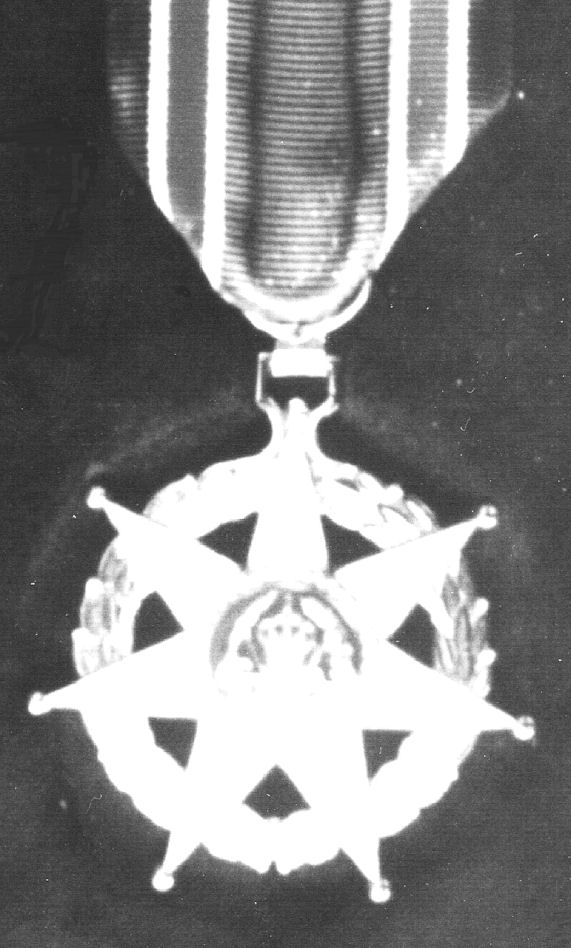
 0
0 -
Wisam al-Iqdam al-?Askari / Order of Military Gallantry
Initially awarded to all ranks of the ?Arab Legion? for the highest gallantry under fire. It was later expanded to a general decoration for the highest gallantry; in many ways it is analagous to the British Victoria Cross. The decoration may be awarded posthuously.
Early awards of the medal were in bronze, but it has later been altered to silver and chrome.
Established: By King Abdulla ibn Hussein in 1946.
Obverse: Circular 40-mm medal, head of King Abdullah ibn Hussain facing left surrounded by an Arabic inscription ?Abdullah ibn al-Hussein / King of the Hashemite Kingdom of Jordan?. Suspended by a ring.
Reverse: Image of Al-Aqsah Mosque (taken from the earlier Palestinian ?1 currency note) and the legend ?Wisam al-Ikdam al-Askari? or ?Order of Military Gallantry?.
Ribbon: 38-mm plain green moir? (?Hashemite Green?).
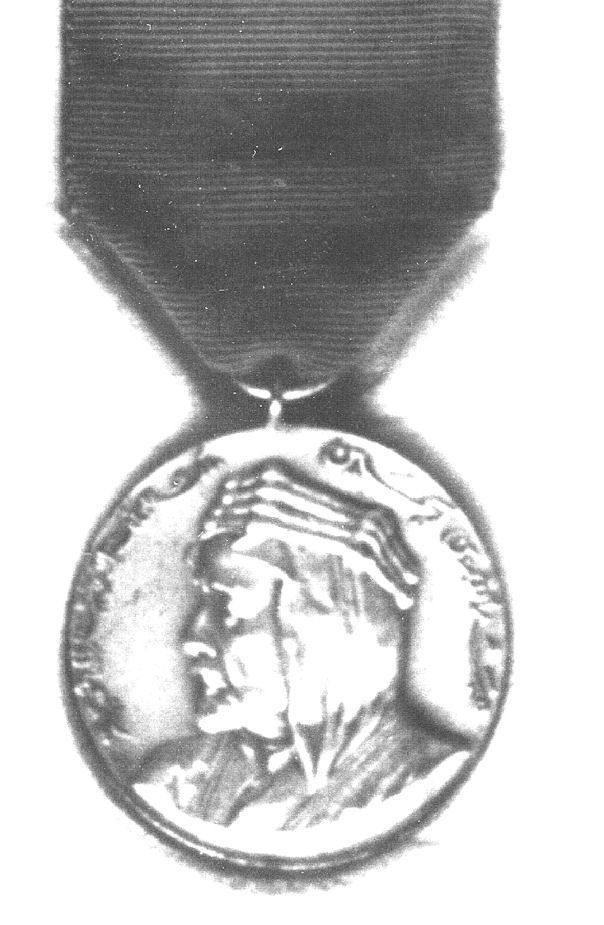
 0
0 -
A few most, most of which I have only as images, and some of these in black and white and some are not of the jhighest quality. Sorry. But the information is, I think, important?
Wisam al-Najat al-Hashemi / Order of the Hasmemite Star
Awarded to all members of the military for the performance of heroic acts of other distinguished services in the face of the enemy.
Established: By King Hussein ibn Talal in 1971.
Obverse: A 50-mm seven-point white-enameled gold star with ball tips on the star, with a wreath behind and an Arabic inscription at the bottom of the wreath ?Wisan al-Najma al-Hashimiya? or ?Order of the Hashemite Star?. In the center, on a gilt seven-pointed green-enemaled star, the gilt head of King Hussein, facing left. Suspended by a crown and ring from an ornate straight-bar suspender.
Reverse: Plain.
Ribbon: 38-mm crimson moire.
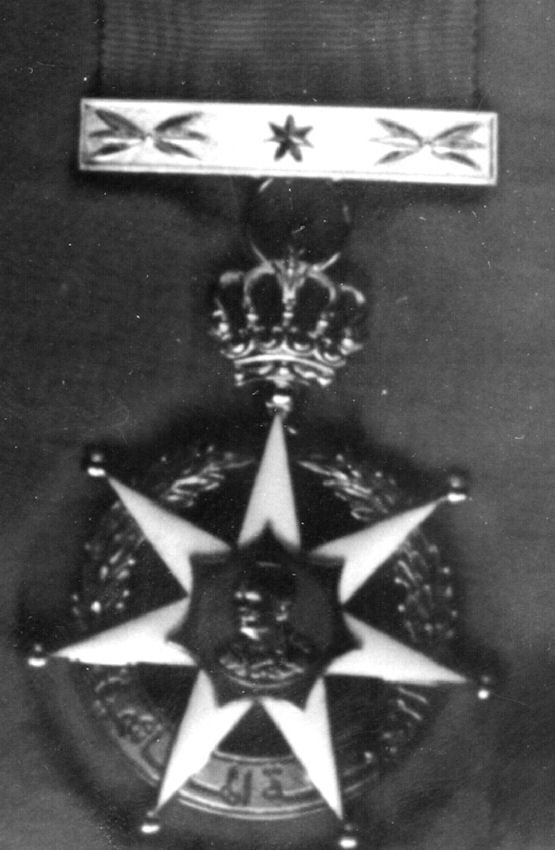
 0
0 -
Ed,
Your inbox seems to need emptying ...
Cheers,
Hendrik
Oops. Sorry. Fixed (a bit). Ed
0 -
Thanks, but no use, as I do not use e$cam. A shame no real book dealers stock it
 Author stupidity?
Author stupidity?Many problems with the Sainty & Heydel-Mankoo work. They got information (I know) and re-worked (= distorted) it.
0 -
Hello Roeland,
The de Roffignac book deals with orders etc. from African countries AFTER their becoming independent. Great book but not on French colonial awards.
Cheers,
Hendrik
Hendrik-
Where can that book be found? Abebooks was no joy.
Thanks,
Ed
0 -
Cost in a Russian museum souvenir gift shop what, $75 ?

In $US, maybe, in any real currency, much less.
 0
0 -
Well done, Leigh!!
 0
0 -
Yes, the 1914-15 Star. These would have been awarded post-war and, as I know these cards, this date woiuld be just to the right off the cropped image you show. (Given my main collecting interests, Indian Army, all those cards were thrown out in the 1970s, so my expwerience is limited.)
The theater of first entry is indeed where he first entered a combat area. Beyond that, you'll need research.
0 -
Likely:
1914-15 Star (possibly 1914 Star, it should say on the MIC card)
Allied Victory Medal
British War Medal
See:
0 -
Yes, I too am confused. And if Spain, by " nationalist" do you mean fascist?
There are, of course, other civil wars than just these two where there were "nationalists" . . .
 0
0 -
Nice to see how much is online, Eddie. Thanks for this reminder.
I had thought the familiar regiments.org might have had something, but it seems to be down just now.
0 -
You must be very careful with many of these 19th-century illustrrations. There is more imagination and fantasy than historical widsom and, to be honest, the French sources are among the worse.
See:
http://www.turkishmedals.net/orders.htm#Turkish%20Crescent
http://www.turkishmedals.net/campmedals.htm#Egypt
For pretty reliable online sources.
For a real source (= a book), see Er?reten, Metin, Osmanli Madalyalari ve Nisanlari (Istanbul: Belgelere Tarihi, 2001), pp. 161-62 where he discusses the Vaka-i Mirriye Madalyasi (Hilai Nişani).
What you show at the beginning seems to be something else, quite modern, and possibly unofficial.
0 -
Thanks for teh update. I look forward to seeing my copy
 . While, like any other book, it may not be the final word, it will be -- to quote the neighbors -- a Great Leap Forward.0
. While, like any other book, it may not be the final word, it will be -- to quote the neighbors -- a Great Leap Forward.0




Rare Chinese army visit Mongolia army
in China
Posted
Nice pictures. Very interesting. Any idea as to the date? As the Chinese seem still to have ranks and as it was in one of those few moments when China and Mongolia were friendly, maybe mid-1950s?